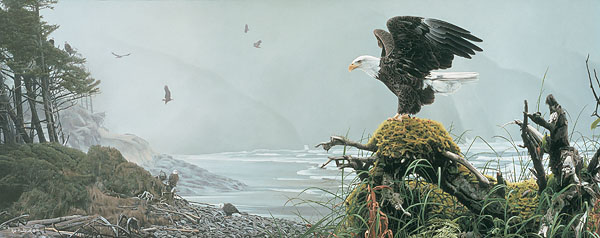Coming Home
The inspiration for this painting came from the early successes in re-populating the West Coast with the bald eagle, our national symbol that had landed on the endangered species list in 1967. Loss of habitat, hunting and the suspected effects of the insecticide DDT on eagle fertility contributed to their steep decline throughout the 19th century. In 2007, the Interior Department took the eagle off the Endangered Species list but the Bald and Golden Eagle Protection Act continues to make it illegal to take, sell, trade or collect eagles or eagle parts.
“It’s one of my favorite subjects to paint,” says Rod Frederick. “I see them all the time here in the Cascades.” Over two thirds of the world’s bald eagle population has “come home” to breed and thrive in Alaska and British Columbia, largely due to the undeveloped land and the salmon fisheries.

